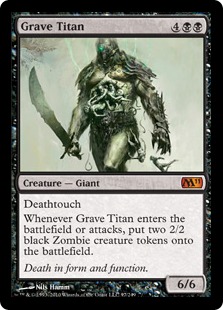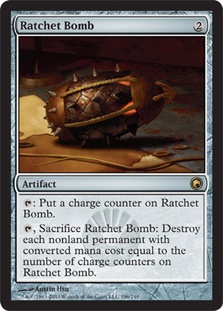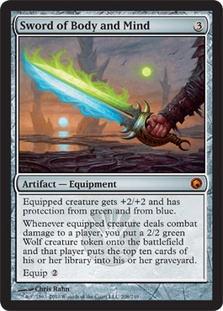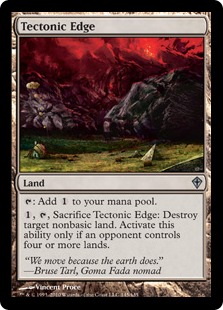The Standard environment is about as well defined as it has ever been at this point in the season. With large events like the StarCityGames.com Open Series producing regular results and the endless decklist machine that is Magic Online working overtime, we have a very good idea about what people are playing.
That’s good news for those of us who have big events coming up, like the StarCityGames.com Invitational or the World Championships. There’s an absolute feast of information out there for anyone willing to look, and I assure you I’ve been looking. On top of poring over hundreds of decklists, I’ve also been doing a lot of gaming myself, playing quite a bit in the two-man queues on Magic Online, as well as the occasional 8-man or Daily Event, and it’s given me a great, practical, hands-on view of the format.
I do want to stop for a quick aside – for all the negative things there are to say about Magic Online, there’s a whole lot of positive there as well. The two-player Constructed queues, for example, didn’t exist many years ago when I played Magic Online regularly, and as a result, it could often be virtually impossible to actually find a competitive game because the 8-man queues just wouldn’t fire often enough. The Tournament Practice Room is full of people who’d quit if you were playing a particular deck or just wouldn’t be quite up to snuff in terms of deck quality or play skill. There’s nothing like putting something on the line to assure people are at least trying to win, and the two-player queues have done that. They give anyone who wants to try out a deck the opportunity to jump in and battle with it at any time of day with a commitment of generally no more than half an hour. Frankly, that’s awesome, and I’m thrilled it exists.
But despite the massive quantity of information out there, there’s still the opportunity to find small edges where others aren’t looking, or at least to take a closer look at what only few seem to have uncovered. That’s what I want to take a look at this week – the unsung heroes of the Standard format. We’ve seen cards like Frost Titan and Abyssal Persecutor go from sleepers to superstars over the past few months, and it’s finding these kinds of cards before they blow up that can be the little extra push a deck needs to put it over the edge.
So without further ado…
It’s funny that I’m talking about Grave Titan as a “sleeper,” because he was one of the Titans first getting top billing when M11 was released. But with the printing of Wurmcoil Engine and the love affair the world has with Frosty the Snow Titan, this big boy has been largely overlooked. I’ve been playing a lot of U/B on Magic Online recently, and my win percentage in many matchups has gone up dramatically since I switched from Frost Titan to Grave Titan.
Let’s compare the two for a moment. Frost Titan helps lock down big threats like opposing Titans, of course, while Grave Titan is much better at providing an immediate board presence against a large number of threats. One might argue that Frost Titan wins heads up, but realistically the Grave
Titan deck has access to Doom Blade, and if you’re talking about the U/B mirror, there are a grand total of zero other meaningful targets, so
Doom_Blade_Guy
is going to have his way with him. Comparatively, Grave Titan is actually an enormous threat that U/B has very few ways to effectively deal with, especially since bouncing him with Jace still leaves his Zombie pals around to sculpt the planeswalker’s brains into dinner.
When I first started playing in the two-man queues, I was playing against a lot of Valukut. What I found was that even if I had a Frost Titan, I couldn’t afford to allow a Primeval Titan to resolve anyway, because they could often either burn me out or kill my Titan despite his icy shield. If Frost Titan wasn’t getting the job done in what was ostensibly his best matchup, what was I playing him for?
Frost Titan looks particularly embarrassing compared to his undead counterpart when you look at some of U/B’s tougher matchups, like Vampires or Kuldotha Red. With Frost Titan in your deck, you’re pretty weak against Bloodghast and company, especially since they tend to hang out with Gatekeeper of Malakir and Vendetta or Doom Blade. Grave Titan is an absolute monster against them, completely stopping their beatdown and limiting their offensive power to Kalastria Highborn.
I’ve also found that many Mono-Red opponents seem to bring Mark of Mutiny in against U/B, hoping to get a big hit in with an Abyssal Persecutor or something. Conveniently, the buddies Grave Titan brings with him make perfectly suitable chump blockers if the situation happens to arise that he turns against you, while Frost Titan getting taken pretty much guarantees you’re taking seven to the chin. I often sideboard out my Persecutors against Mono-Red as it is, because they can quite easily kill you from negative life before you can get rid of it, so playing Grave Titan over Frosty can make Threaten effects rot in their hand if they do bring them in.
Frost Titan may be the new hotness, but I feel pretty strongly that if you have the choice between them, Grave Titan is the man for the job.
As all the information regarding the most successful decks in Standard has pointed to decks built around Jace and the Titans in the past few months, it was inevitable that players would turn their gazes to beating these decks. We’ve seen a number of strategies rise up recently that seem aimed to beat the raw power of the top dogs with sheer speed, from the Quest for the Holy Relic deck that was so hyped prior to the release of Scars to the Kuldotha Red and Vampire rush decks alluded to earlier. These decks all have one thing in common, and that is a reliance on cheap permanents to overwhelm their opponents before they can establish control.
Enter Ratchet Bomb. Ratchet Bomb is a largely unheralded card from Scars of Mirrodin that hasn’t really seen a great deal of play but seems perfectly positioned for many of the top decks to use as a weapon against the rush decks. Against Vampires it can wipe out a board of Lacerators, Pulse Trackers, and Viscera Seers before they can get enough damage in to make the Highborn burn plan a real threat. Against Kuldotha Red, it can sweep the board of Memnites and Goblin tokens without having to even wait a turn, and against Quest decks it can destroy their creatures, destroy their equipment, or even destroy their namesake Quest itself.
While Ratchet Bomb is clearly at its best against these rush decks, what’s more exciting about it in my mind is that it’s a sufficiently versatile card that it can easily be played maindeck. It can take out an opposing Jace, destroy a Journey to Nowhere on a Titan, kill your opponent’s Joraga Treespeakers or Everflowing Chalices, or even nail a Pyromancer Ascension before it becomes a problem. We may have lost Oblivion Ring as a catchall solution, but Ratchet Bomb is a passable way to deal with a wide range of problems that happens to be positioned very well in the environment with the recent shift toward aggressive decks.
It may not be as fast as Pyroclasm or as devastating as Consume the Meek when they’re at their best, but Ratchet Bomb is a serious role player that can be backbreaking in many situations. If you’re playing a deck that might be light against the rush decks, I’d strongly consider trying to fit a few copies of Ratchet Bomb into your deck to shore things up. I think you’ll be happy you did.
Sword of Body and Mind is a card that sees a lot of play in Stoneforge Mystic decks like Quest combo and Boros. I bring it up as a sleeper because I think it’s a card that deserves a lot more consideration than it gets in other contexts. In an environment defined by Jace and company, with various flavors of U/G/x decks showing up at the top tables everywhere, Sword of Body and Mind is a card that threatens to absolutely dominate games when equipped to just about any creature around.
Consider a G/U/R mirror match. Imagine playing a second-turn Lotus Cobra, then on the third turn playing a fetchland, cracking it, and suiting up the Cobra and attacking. You now have a 4/3 creature that has protection from every non-Lightning Bolt card in your opponent’s deck, a 2/2 Wolf, and you’ve milled him for ten cards! Your opponent is most likely drawing to literally four outs at that point!
The truly insane thing is that it doesn’t even have to be a super fast Sword/Equip to be just as devastating. Your opponent could have a Frost Titan in play, and you drop a sword and suit up your Cobra, send it over, and then equip the Sword to the new Wolf you just made. What is your opponent going to do? You have a 4/4 creature that he can’t tap down with his Titan, so he can’t really attack, and you can just do the exact same thing next turn. Rinse and repeat until dead.
I’m not sure what all of the possible homes for the Sword are, but I’d definitely try it out in the sideboard of U/G/R to get an edge in the mirror or in any kind of Vengevine deck to help push past Frosty and friends. When Sword first came out, it didn’t look nearly as impressive as its predecessors, but the environment seems just right for it to make a big splash and show grandpa and grandma that Mirrodin swords still have what it takes to play on the big stage.
Now this is a weird one, because Tectonic Edge is a card that does see a lot of play, but I wanted to mention it because it’s a card a lot of people only think about in a very specific context – that is, as a maindeck card.
At PT San Juan, I played a B/U/G Oracle/Jace deck, very similar in concept to the R/U/G deck that was quite popular but with black removal and Ob Nixilis as our big finisher in an attempt to get an edge against the R/U/G decks and Eldrazi Green. The details really aren’t relevant, but what is relevant is that we were playing a deck that was incredibly color-hungry and couldn’t afford to play any colorless lands in the main. In our testing against Eldrazi Green, however, we found that Tectonic Edge was one of the most powerful cards available for keeping them off their huge monsters or All Is Dust.
As a result, we chose to sideboard Tectonic Edges. The Edges also gave us more ways to deal with opposing manlands against U/W and let us actually sideboard up to the hefty total of 31 lands in those matchups where we wanted our deck to be nothing but huge threats, acceleration, and mana.
Two of the most important elements of “Jace wars” in the current Standard are having sufficient ways to deal with opposing manlands and making your land drops so you can play around Mana Leak and Spell Pierce. Tectonic Edge fills both those roles and, what do you know, also happens to be a strong card against Eldrazi Green and Valukut in this format as well. Tectonic Edge can often be the perfect choice for the sideboard of decks that are looking to gain percentage against control and ramp decks, even if it can’t fit into the main. Just because it’s a land doesn’t mean it can’t still be a sideboard card!
That’s all I’ve got for this week. This weekend I’ll be in Nashville battling it out. If you’re around, feel free to drop by and say hello!
Until next time,
bmk




